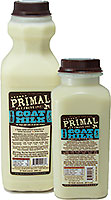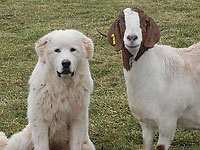When we think of milk, we think of cows. But throughout history, people around the world have enjoyed fresh, raw and fermented milk from a variety of animal species including yak, camel, reindeer, donkey, water buffalo, sheep and goat. Goat milk, not cow milk, is actually the most consumed milk in the world. Often referred to as the universal mammalian milk, goat milk is now gaining popularity in the US – for both people and our pets.
 Over the past century, milk from cows and other species has been closely studied and analyzed for its nutrient (protein, fat, carbohydrate) content, as well as for specific micro-nutrients. Researchers have found that the basic composition or macro-nutrients in milk varies from species to species. Dog and cat milk, for instance, has a higher fat and protein content than the milk from most ruminant species like cows and sheep. This shouldn’t come as a surprise, because carnivorous cats and dogs differ from cows and their physiology and dietary needs. Over the past century, milk from cows and other species has been closely studied and analyzed for its nutrient (protein, fat, carbohydrate) content, as well as for specific micro-nutrients. Researchers have found that the basic composition or macro-nutrients in milk varies from species to species. Dog and cat milk, for instance, has a higher fat and protein content than the milk from most ruminant species like cows and sheep. This shouldn’t come as a surprise, because carnivorous cats and dogs differ from cows and their physiology and dietary needs.
There are other important differences in milk that we should also be aware of.
Why Is Raw Goat Milk A Better Choice?
Raw milk is something that our government likes to tell us is unhealthy for us and could be riddled with disease. It’s about as rare as getting hit by a bus but that could be an entirely new article. All dairy products that are available for commercial purchase have been pasteurized. Pasteurization kills all enzymes making us susceptible to intolerances as well as lacking minerals often provided by raw milk.
According to the Journal of American Medicine, “Goats milk is the most complete food known.” It contains vitamins, minerals, electrolytes, trace elements, enzymes, protein, and fatty acids utilized by the body with ease. In fact, the body can digest goat’s milk in only 20 minutes. It contains preformed Vitamin A in the milk fat that allows it to be readily available for use by the body. Goat milk contains a higher evolved carotene (pro-Vitamin A). Researchers find the pro-Vitamin A to have cancer-preventing properties.
The protein in goat milk forms a softer curd (the term given to the protein clumps that are formed by the action of stomach acid on the protein), which makes the protein more easily and rapidly digestible making it perfect for our pets. Although the mineral content of goat’s milk and cow’s milk is generally similar, goat’s milk contains 13 percent more calcium, 25 percent more vitamin B-6, 47 percent more vitamin A, 134 percent more potassium, and three times more niacin. It also contains 27 percent more of the antioxidant selenium than cow’s milk.
Goat’s milk has long been used and recommended as an aid in the treatment of ulcers due to its more effective acid buffering capacity. Goat’s milk has more buffering capacity than over the counter antacids. The USDA and Prairie View A&M University in Texas have confirmed that goat’s milk has more acid-buffering capacity than cow’s milk, soy infant formula, and nonprescription antacid drugs.
Goat’s milk alkalinizes the digestive system. It actually contains a group of alkaline minerals, and it does not produce acid in the intestinal system. Goat’s milk helps to increase the pH of the blood stream because it is the dairy product highest in the amino acid L-glutamine. L-glutamine is an alkalinizing amino acid, often recommended by nutritionists that can help repair leaky gut syndrome.
Raw Goats Milk Does the Body Good
With all of those surprising nutritional facts, what is most forgotten is that goat’s milk provides the highest amount of the mineral fluorine but is destroyed during pasteurization or any cooking process. Fluorine in conjunction with calcium, forms strong bones, tough tooth enamel along with healthy hair and nails. Certain glands and organs, such as the spleen, are also dependent on fluorine. This trace mineral also acts as a purifier, disinfectant, germicide and building block throughout the body. When there is an adequate amount of fluorine present in the body, this element ensures a youthful life. And let’s not confuse natural fluorine with synthetic fluoride that is commonly put in drinking water. Fluoride is toxic and is a by-product of the phosphate fertilizer industry or aluminum production causing much more harm than good.
Having fat molecules one-fifth the size of those in cow’s milk makes it easily digestible and tolerable even for dogs with digestive issues. Raw goat milk is a source of easily digested probiotics that can help with many chronic diseases, including:
• Liver disease
• Heavy metal poisoning
• Malnutrition
• Kidney disease
• Kidney stones
• Diabetes
• GI disease
• Poor digestion
• Diarrhea
What about Lactose Intolerance?
The problem of lactose intolerance grew as milk pasteurization increased. Lactose is a milk sugar that requires the enzyme lactase to split it into simple sugars for easy digestion. Raw milk is rich in lactase enzyme, but pasteurization and heat destroy the lactase enzyme. Many pets that don’t produce the lactase enzyme can’t digest pasteurized milk but can digest raw goat milk without problems.
Consider The Source…
The nutritional value of goat milk does depend on the diet and overall health of the animals that are producing it. Goats that are pastured and grass fed in a low stress environment, free of antibiotics and free of GMO feeds will produce far better quality milk. Processing, such as pasteurization or spray drying, will also lower the nutritional value of the milk.
The Moab BARKery sells raw goat milk…
Primal Raw goat milk is a great digestive aid as it helps pets obtain their daily need for moisture. Dogs’ and cats’ bodies are about 65% moisture and unlike humans, they are designed to obtain the majority of their water from the foods they eat. By adding raw goat milk (79% moisture) to your pet’s diet, they will be gaining needed moisture as well as the benefits from raw nutrients. Primal raw goat milk is from free-range, pastured goats without hormones or antibiotics and in addition they add cinnamon for assistance with arthritis and muscular inflammation, ginger as a digestive aid and natural antioxidant, turmeric as an antioxidant and detoxifier, lactobacillus acidophilus for immune resistance, lactobacillus lactis for synthesizing B vitamins that may aid in treating irritable bowel disease and enterococcus faecium which provides nutritional support for gastrointestinal diseases. Primal raw goat milk is sold frozen and should be stored in the freezer prior to use. Bottles should be placed in the refrigerator to defrost 24 hours prior to using. Milk will settle between uses. Shake well prior to feeding. Primal raw goat milk will last 10 days after being thawed or 1 year frozen.
As with all raw products, we recommend a slow transition when introducing new food products to any pet. We recommend starting with ¼ of the daily feeding quantity as an introductory portion.
|